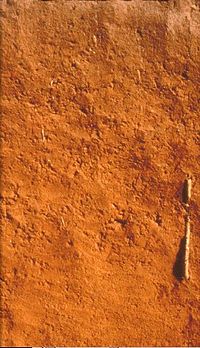Oxisol
This articleneeds additional citations forverification.(July 2022) |
| Oxisol | |
|---|---|
 Oxisol profile | |
| Used in | USDA soil taxonomy |
| Profile | OABC |
| Key process | leaching,weathering |
| Climate | tropical |
Oxisolsare asoilorder inUSDA soil taxonomy,best known for their occurrence intropicalrain forestwithin 25 degrees north and south of theEquator.In theWorld Reference Base for Soil Resources(WRB),[1]they belong mainly to theferralsols,but some areplinthosolsornitisols.Some oxisols have been previously classified aslateritesoils.
Formation
[edit]The main processes ofsoil formationof oxisols areweathering,humificationandpedoturbationdue to animals. These processes produce the characteristicsoil profile.They are defined as soils containingat all depthsno more than ten percent weatherableminerals,and lowcation exchange capacity.Oxisols are always a red or yellowish color, due to the high concentration ofiron(III) andaluminiumoxidesandhydroxides.They also containquartzandkaolin,plus small amounts of otherclay mineralsandorganic matter.
Etymology
[edit]The word "oxisol" comes from"oxide"in reference to the dominance of oxide minerals such asbauxite.In theWorld Reference Base for Soil Resources,oxisols are known asferralsols.
Occurrence
[edit]Present-day oxisols are found almost exclusively in tropical areas, inSouth AmericaandAfrica,almost always on highly stable continentalcratons.
InSoutheast Asia,oxisols are found on remnants of theCimmerian microcontinent,and on theShan–Thai Terrane.InThailand,rhodic ferralsols, calledYasothonsoils, are said to have formed under humid tropical conditions in the earlyTertiary,on an extensive plain later uplifted to form theKhorat Plateau.Characterized by a bright red color, theserelictsoils occur on uplands in a great semicircle around the southern rim, overlying associatedgravelhorizonssaid to have been cleared ofsandbytermites,in a prolonged and still on-going process ofbioturbation.Xanthic ferralsols of theKhoratandUdonseries, characterized by a pale yellow to brown color, developed in midlands in processes still under investigation; as are those forming lowland soils resembling Europeanbrown soils.[2]
InAustraliavast areas formerly covered in rainforest have become so dry that oxisols have formed a hardironstonecover upon which onlyskeletal soilscan form.
Genesis
[edit]Fossiloxisols are known from the first appearance of freeoxygenin theatmosphereabout 2,200 million years ago. In warm periods like theMesozoicandPaleocene,oxisols extended to areas that now have quite cool climates, extending well intoNorth AmericaandEurope.It is believed oxisols became vegetated later thanultisolsoralfisols,probably because vegetation took a long time to adapt to the infertility of oxisols.
History
[edit]Scientists originally thought that the heavy vegetation of tropicalrain forestswould provide rich nutrients, but as rainfall passes through the litter on the forest floor the rain isacidifiedand leachesmineralsfrom the above soil layers. This forces plants to get their nutrition from decaying litter as oxisols are quite infertile due to the lack of organic matter and the almost complete absence of soluble mineralsleachedby the wet and humidclimate.
Uses
[edit]Oxisols are often used for tropical crops such ascocoaandrubber.In some cases,riceis grown on them. Permanent cropping of oxisols in low-income areas is very difficult because of lowcation exchangecapacities and highphosphorusfixation on iron and aluminium oxides (ligand exchange mechanism;inner sphere complexwith phosphate). However, many oxisols can be cultivated over a wide range of moisture conditions. On this account, oxisols are intensively exploited for agriculture in some regions which have enough wealth to support modern agricultural practices (including regular additions oflimeandfertilizer). A recent example of exploitation by modern methods involves the growing ofsoybeansinBrazil.
Suborders
[edit]Oxisols are divided into the following suborders:
- Aquox– oxisols with a water table at or near the surface for much of the year
- Perox– oxisols of continuously humid climates, where precipitation exceeds evapotranspiration in all months
- Torrox– oxisols of arid climates. Because the present climate can never produce enough weathering to produce oxisols, torrox soils are alwayspaleosolsformed during periods of much wetter climates. They occur mainly inSouthern Africa.
- Ustox– oxisols of semiarid and subhumid climates
- Udox– oxisols of humid climates
See also
[edit]- Pedogenesis– Process of soil formation
- Pedology– Study of soils in their natural environment
- Soil classification– Systematic categorization of soils
- Terra preta– Very dark, fertile Amazonian anthropogenic soil
References
[edit]- ^IUSS Working Group WRB (2022)."World Reference Base for Soil Resources, fourth edition"(PDF).International Union of Soil Sciences, Vienna.
- ^Lofjle, E.; Kubiniok, J.Landform development and bioturbation on the Khorat plateau, Northeast Thailand,Nat.Hist.Bull.Siam Soc. (56), 1996"Archived copy"(PDF).Archived fromthe original(PDF)on 2011-07-21.Retrieved2010-12-23.
{{cite web}}:CS1 maint: archived copy as title (link)
- Buol, Hole, and McCracken, (1997). ‘Soil Genesis and Classification.’ 4th edition. (TheIowa State University Press,Ames, Iowa.)
- "Oxisols".USDA-NRCS. Archived fromthe originalon 2006-02-06.Retrieved2006-05-14.
- "Oxisols".University of Florida. Archived fromthe originalon September 16, 2006.Retrieved2006-05-14.
- "Oxisols".University of Idaho. Archived fromthe originalon 2006-06-04.Retrieved2006-05-14.
Further reading
[edit]- W. Zech, P. Schad, G. Hintermaier-Erhard: Soils of the World. Springer, Berlin 2022, Chapter 10.3.1.ISBN978-3-540-30460-9
External links
[edit]- profile photos (with classification)WRB homepage
- profile photos (with classification)IUSS World of Soils
